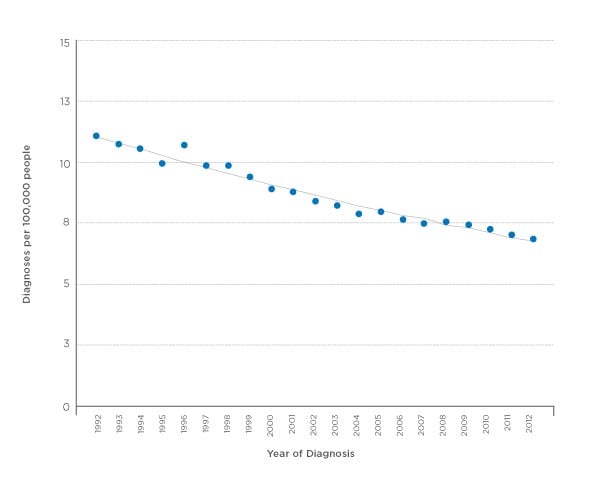Cervical cancer facts
First, the good news: the number of women diagnosed with cervical cancer has steadily declined in recent decades, and the majority of women diagnosed with the disease are surviving for at least 10 years.
Rate of cervical cancer
 Rates for U.S. population. Data from the National Cancer Institute Surveillance, Epidemiology, and End Results Program. Source: seer.cancer.gov
Rates for U.S. population. Data from the National Cancer Institute Surveillance, Epidemiology, and End Results Program. Source: seer.cancer.govThe bad news --
- At any given time, about 250,000 American women are living with cervical cancer.
- Almost 13,000 women are diagnosed with cervical cancer each year.
- Women of African American and Hispanic descent are more likely to be diagnosed with cervical cancer than whites.
- Risk factors:
- Infection with the human papillomavirus, or HPV, dramatically increases a woman’s risk of cervical cancer. Her risk increases further if she smokes or uses oral contraceptives over many years.
- Exposure to the dry cleaning chemical perchloroethylene, or PERC, and styrene, used to manufacture some plastics and rubber, may increase risk of cervical cancer.
- Children of women who took the synthetic estrogen diethylstilbestrol, or DES, to prevent miscarriages were at increased risk, but physicians stopped prescribing DES in 1971.
Prevention tips
- Get vaccinated against HPV.
- Don’t heat food or drinks in plastic containers because some plastics release chemicals that disrupt the hormone system.
- Dry clean clothing only when necessary and patronize dry cleaners that use PERC alternatives such as wet or carbon dioxide cleaning methods.
- Have regular Pap and HPV screenings; these tests can identify precancerous cells and early stages of disease which can usually be cured.
For more information, the National Cancer Institute has a handy booklet on symptoms, screening and available treatments for cervical cancer.
Disqus Comments